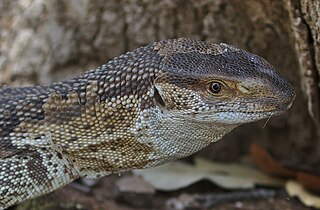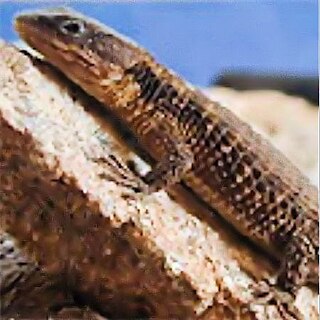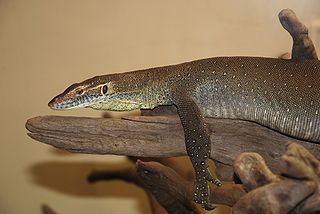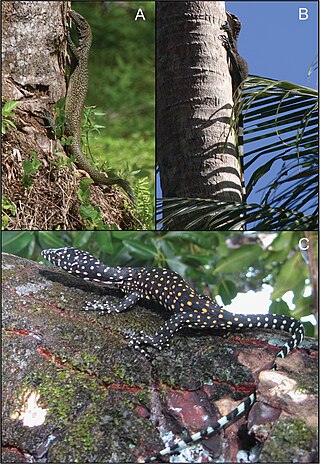
Monitor lizards are lizards in the genus Varanus, the only extant genus in the family Varanidae. They are native to Africa, Asia, and Oceania, and one species is also found in the Americas as an invasive species. About 80 species are recognized.
François Marie Daudin was a French zoologist.

The Nile monitor is a large member of the monitor family (Varanidae) found throughout most of Sub-Saharan Africa, particularly in drier regions, and along the Nile River and its tributaries in East Africa. Additionally, there are modern, invasive populations in North America. The population found in West African forests and savannahs is sometimes recognized as a separate species, the West African Nile monitor. While it is dwarfed by its larger relatives, such as the Komodo dragon, the Asian water monitor or the crocodile monitor, it is still one of the largest lizards in the world, reaching Australia’s perentie in size. Other common names include the African small-grain lizard, as well as iguana and various forms derived from it, such as guana, water leguaan or river leguaan.

The Bengal monitor, also called the Indian monitor, is a species of monitor lizard distributed widely in the Indian subcontinent, as well as parts of Southeast Asia and West Asia.

The savannah monitor is a medium-sized species of monitor lizard native to Africa. The species is known as Bosc's monitor in Europe, since French scientist Louis Bosc first described the species. It belongs to the subgenus Polydaedalus.

The white-throated greenbul, or white-throated bulbul, is a species of passerine bird in the bulbul family, Pycnonotidae. It is found in many parts of central and western Africa. Its natural habitats are subtropical or tropical moist lowland forests and subtropical or tropical moist montane forests. It was formerly considered to be conspecific with the Angola greenbul.

The white-throated monitor is a lizard found in southern Africa. They are usually gray-brown with yellowish or white markings, and can reach up to 2 metres (6.6 ft) in length. They are found in Southern Africa, northwards to Angola, Zambia, and Mozambique.

The Angolan girdled lizard, also known as the Angolan spiny-tailed lizard, is a species of lizard in the genus Cordylus. The species is endemic to Angola, as its names testify, and is ovoviviparous.

The rock monitor is a species of monitor lizard in the family Varanidae. The species is endemic to sub-Saharan Africa, where, on average it is the largest lizard found on the continent. It is called leguaan or likkewaan in some areas.

The black-throated monitor is a subspecies of monitor lizard in the family Varanidae. The subspecies is native to Tanzania.

Mertens' water monitor, often misspelled Mertin's water monitor, is a species of monitor lizard. The species is endemic to northern Australia, and is a wide-ranging, actively foraging, opportunistic predator of aquatic and riparian habitats. It is named after German herpetologist Robert Mertens.

The peach-throated monitor, also known as the Sepik monitor, is a species of monitor lizard native to New Guinea.
The black-spotted ridge-tailed monitor, also called commonly the black-spotted spiny-tailed monitor, the lemon-throated monitor, the northern ridge-tailed monitor, Whites monitor, and the yellow-throated monitor, is a subspecies of lizard in the family Varanidae. The subspecies is native to Australia's tropical Northern Territory. It is listed as Least Concern on the IUCN Red List as it is considered common and not threatened. It was first described in 1987. It is also known as White's dwarf goanna.

The turquoise monitor is a species of monitor lizards found in Indonesia. Specifically, it is found on Halmahera Island and in the Maluku Islands.

The blue-tailed monitor, blue-tailed tree monitor or Kalabeck's monitor, is a monitor lizard of the Varanidae family. It belongs to the V. doreanus group of the subgenus Euprepiosaurus.
The Rennell Island monitor is a species of monitor lizards found in the Solomon Islands archipelago. It is also known as the Hakoi Monitor. It belongs to the subgenus Euprepiosaurus along with the canopy goanna, the peach-throated monitor, Kalabeck's monitor, and others.

The Mussau Island blue-tailed monitor or Mussau monitor is a species of monitor lizard endemic to Mussau Island in Papua New Guinea. It belongs to the Varanus doreanus species complex.

Varanus darevskii, also known as the Central Asian monitor, is an extinct species of monitor lizard from the Early Pliocene of Tajikistan, known from a partial skull. V. darevskii might have been a close relative of, and perhaps ancestral to, the modern desert monitor.
















